Floral designs have long been a powerful way for cultures to express their identity, values, and aesthetics. Whether it’s a temporary art installation, a meticulously curated garden, or a large-scale floral display in a public space, flowers have a unique way of capturing the essence of a city. From the vibrant streets of Tokyo to the cultural heart of Paris, these elaborate floral designs not only brighten urban landscapes but also tell a story — of a city’s history, its people, its traditions, and its aspirations.
In this article, we’ll explore 21 stunning floral designs around the world, each reflecting the spirit of the city in its own unique way.
The Role of Floral Designs in Urban Aesthetics
Floral designs in cities are more than just visual spectacles — they are symbols of a city’s culture, identity, and environmental consciousness. Historically, flowers have held deep cultural significance, from being used in religious rituals to marking significant events in history. In modern times, cities use flowers to enrich public spaces, commemorate festivals, and connect urbanites to nature.
Historical Significance of Floral Art in Cities
Many cities, especially in Europe and Asia, have a longstanding tradition of cultivating public gardens, botanical parks, and floral arrangements as a means of beautification. For instance, the grandeur of gardens in cities like Paris and London reflects the importance of public gardens in the cultural life of these cities. These spaces were designed not just to display flowers but also to represent civic pride and cultural heritage.
Floral Design as a Representation of City Identity
Each city’s floral designs are often deeply intertwined with local traditions and natural resources. For example, the tulip fields of the Netherlands or the lotus flowers in Japan carry cultural and historical significance. The types of flowers used in these designs can reveal a great deal about a city’s geographical and social landscape.
Modern Urban Trends in Floral Design
In recent years, many cities have embraced more sustainable and eco-conscious floral design practices. This includes planting native species, using organic materials, and creating green spaces that promote biodiversity. Floral art has also evolved to become more dynamic — featuring temporary installations, interactive designs, and installations that respond to the changing seasons.
Exploring 21 Elaborate Floral Designs
1. The Tokyo Skytree Flower Dome (Tokyo, Japan)

Located within the Tokyo Skytree, the world’s tallest tower, the Flower Dome is a spectacular floral display that marries traditional Japanese floral aesthetics with modern design elements. The installation features meticulously arranged flowers like chrysanthemums, lilies, and orchids, artfully arranged in ways that reflect Japan’s age-old flower arranging traditions, known as ikebana. This floral display captures the dual essence of Tokyo: a city deeply rooted in tradition yet relentlessly forward-looking.
2. Flower Carpets at Brussels Flower Carpet (Brussels, Belgium)
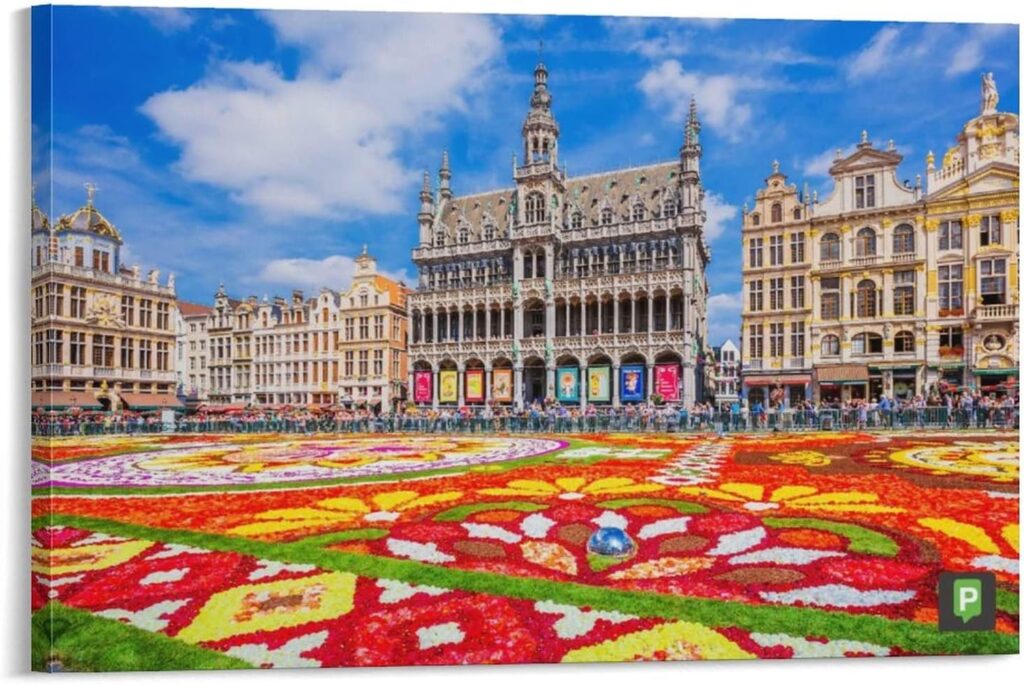
Every two years, the Grand Place in Brussels is transformed into a sprawling canvas of flowers. The Flower Carpet festival showcases an elaborate tapestry of over 1 million begonias, arranged in intricate patterns that reflect both local and international themes. The installation celebrates Belgium’s rich history in floriculture and the craftsmanship of its artisans. It’s an unforgettable experience that beautifully represents the cultural heritage of Brussels and the city’s flair for artistry.
3. New York’s Macy’s Flower Show (New York City, USA)
Macy’s flagship store in New York hosts one of the most iconic flower shows in the world. Each spring, the store’s 5th Avenue windows and surrounding space are filled with vibrant floral displays that draw inspiration from global destinations. From tropical themes to cityscapes made entirely of flowers, this floral extravaganza highlights New York’s cosmopolitan identity and its constant reinvention as a center of creativity and innovation.
4. The Keukenhof Gardens (Lisse, Netherlands)
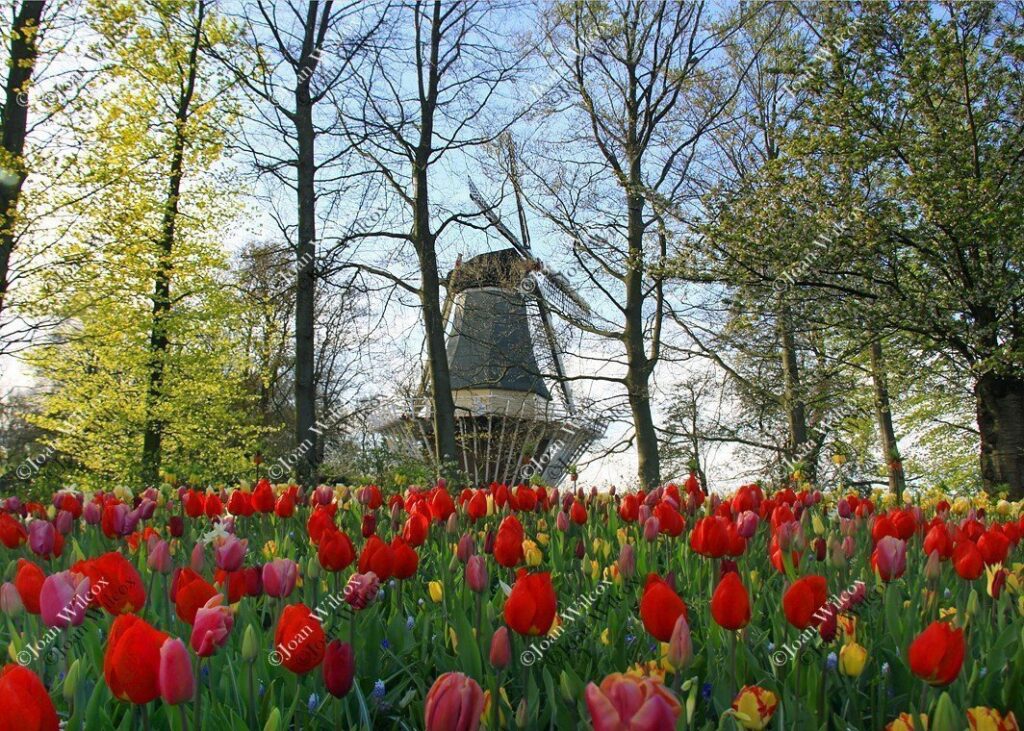
Keukenhof, the famed “Garden of Europe,” is home to millions of tulips and other flowers that bloom in elaborate displays each spring. The garden’s floral designs change each year, with themes ranging from classic to contemporary. The Netherlands is known for its floral heritage, and Keukenhof is an embodiment of Dutch culture, which values precision, innovation, and beauty. The garden reflects the country’s passion for horticulture and its deep connection to flowers.
5. Singapore’s Gardens by the Bay Floral Displays (Singapore)

A futuristic garden in the heart of Singapore, Gardens by the Bay is home to a series of stunning floral designs that change throughout the year. From vibrant floral conservatories to the striking Supertree Grove, the space integrates nature and technology in a way that defines Singapore’s identity. The city’s commitment to sustainability and green urban planning is evident in its use of flora as both an aesthetic and environmental tool.
6. The Dubai Miracle Garden (Dubai, UAE)
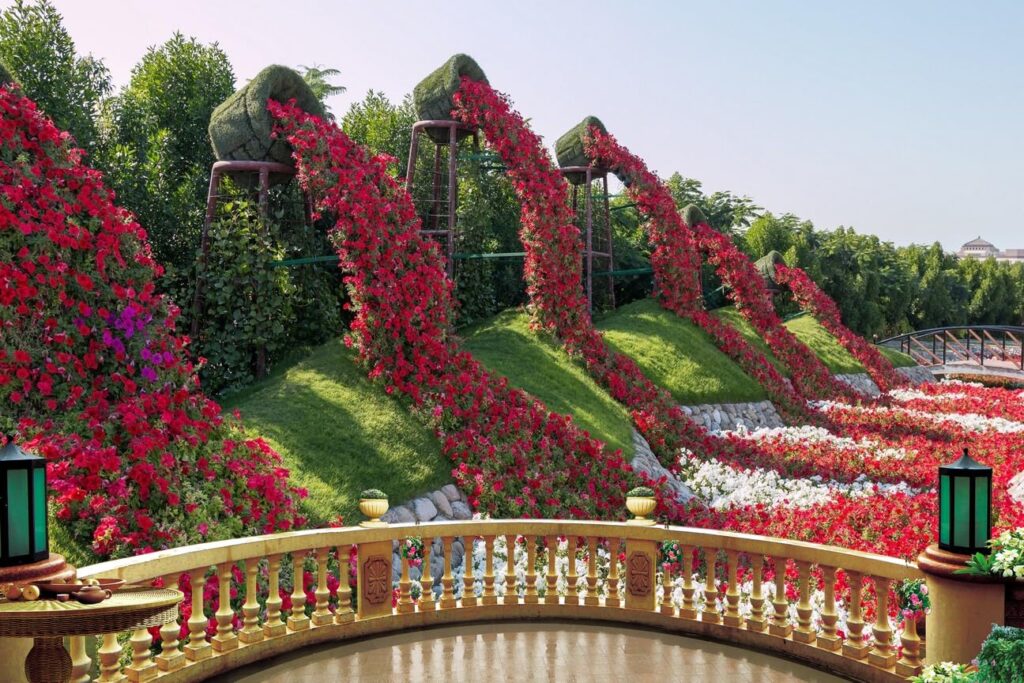
The Dubai Miracle Garden is a stunning floral display that takes center stage each winter, boasting over 50 million flowers arranged in intricate designs. It’s home to larger-than-life sculptures made entirely of flowers, including everything from a life-size Emirates airplane to a heart-shaped archway. The Miracle Garden epitomizes Dubai’s larger-than-life ambition, blending luxury, innovation, and nature in one breathtaking space.
7. The Chelsea Flower Show (London, UK)

Held annually in London, the Chelsea Flower Show is one of the most prestigious flower exhibitions in the world. The show brings together the finest floral designers, horticulturists, and garden architects from around the globe. From whimsical garden designs to more formal floral installations, the Chelsea Flower Show captures the quintessential British love for elegance, nature, and understated beauty.
8. The Garden of 5 Senses (New Delhi, India)

Located in New Delhi, the Garden of 5 Senses is a sensory garden that invites visitors to experience flowers in a more tactile, interactive way. The garden is designed to engage all five senses, with fragrant flowers, visually striking layouts, and textured plants. The design reflects India’s deep connection to nature, as well as its cultural emphasis on multisensory experiences in everyday life.
9. Vancouver’s Bloedel Conservatory (Vancouver, Canada)

Bloedel Conservatory is an indoor tropical garden that features lush flowers from around the world, set against a stunning backdrop of a geodesic dome. The conservatory is part of Vancouver’s commitment to blending nature with urban life. The diverse floral species reflect Vancouver’s cultural diversity and its ongoing efforts to integrate nature within its rapidly developing urban landscape.
10. The Paris Flower Markets (Paris, France)

Paris is a city synonymous with elegance, and its flower markets are no exception. The Marché aux Fleurs, located in the heart of the city on Île de la Cité, is a historical flower market where both Parisians and visitors can purchase vibrant flowers, from roses to orchids. The market reflects Paris’ timeless beauty and romantic allure, while also underscoring the city’s love for fine art, nature, and craftsmanship.
11. Seoul’s Seoul Botanic Park (Seoul, South Korea)

Seoul Botanic Park blends the city’s modernity with its natural environment. The park features a variety of floral installations that celebrate both Korean horticultural traditions and global gardening practices. It’s a perfect example of how Seoul harmonizes its technological advancements with a deep respect for nature. The park’s floral designs are reflective of South Korea’s deep-rooted love for nature and its determination to incorporate green spaces into urban life.
12. The Norrköping Light Festival (Norrköping, Sweden)

The Norrköping Light Festival is a magical event that combines floral-inspired installations with light art. During the festival, the Swedish city is illuminated with floral-themed light sculptures that transform the cityscape into a glowing wonderland. This event highlights Sweden’s deep appreciation for art, light, and nature — especially during the long, dark winters.
13. The Montreal International Floral Art (Montreal, Canada)
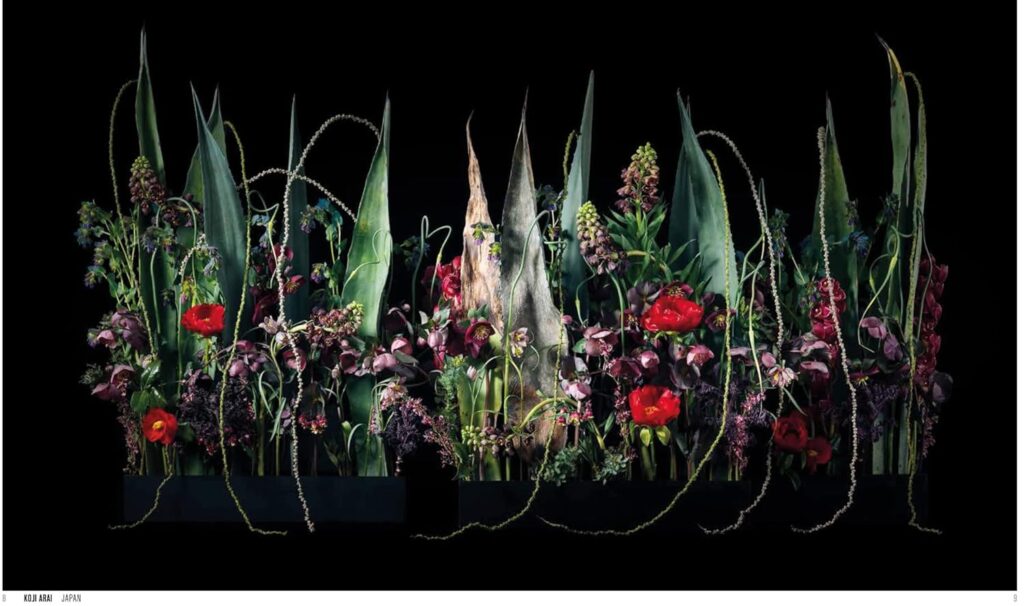
Montreal is known for its diverse cultural scene, and its International Floral Art event is no exception. The city hosts an annual event where floral artists from all over the world display their designs in elaborate installations. The displays are often innovative, bold, and reflective of Montreal’s multicultural identity and artistic spirit.
14. The Flower Festival of Medellín (Medellín, Colombia)
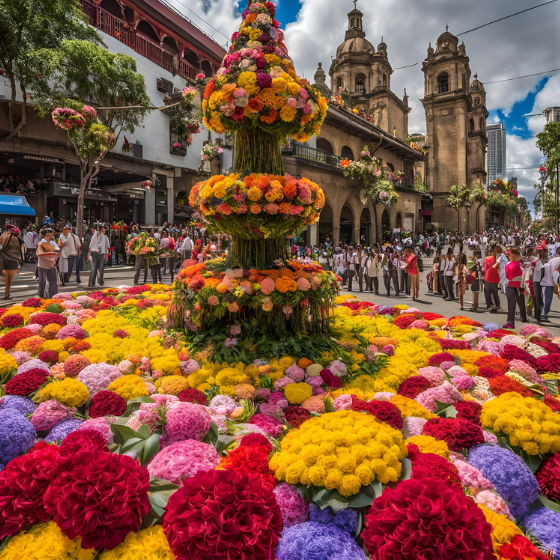
Medellín’s Flower Festival is a city-wide celebration where flowers take center stage. The highlight of the festival is the Desfile de Silleteros, where locals carry elaborately designed flower arrangements on their backs. This vibrant festival celebrates the cultural traditions of the region, with flowers symbolizing the city’s resilience, beauty, and community spirit.
15. The Funchal Flower Festival (Madeira, Portugal)

Funchal, the capital of Madeira, hosts a spectacular Flower Festival each spring. The event features street parades, floral displays, and vibrant flower markets. It is a celebration of the island’s natural beauty, with designs showcasing the colorful and exotic flora native to the region. The festival encapsulates Madeira’s identity — a lush, blooming paradise full of life and color.
16. The Hangzhou West Lake Flower Show (Hangzhou, China)
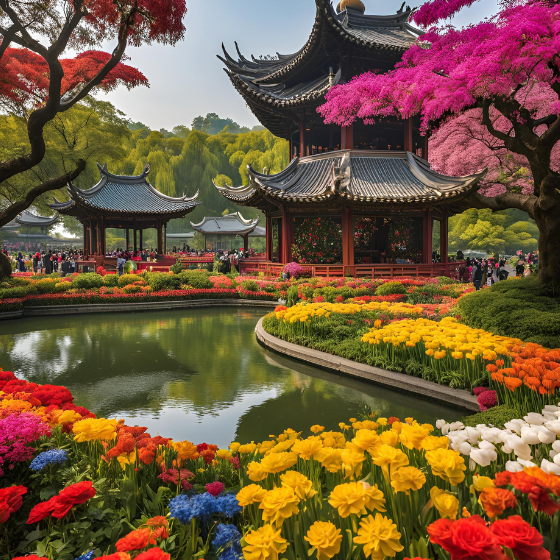
The West Lake in Hangzhou is famous for its scenic beauty, and during the annual flower show, it becomes even more spectacular. The lake’s surrounding areas are adorned with flowers in beautiful arrangements that reflect the elegance and serenity of the region. This floral show blends China’s traditional love for nature with modern design, creating a peaceful yet awe-inspiring atmosphere.
17. The Edinburgh International Festival (Edinburgh, UK)
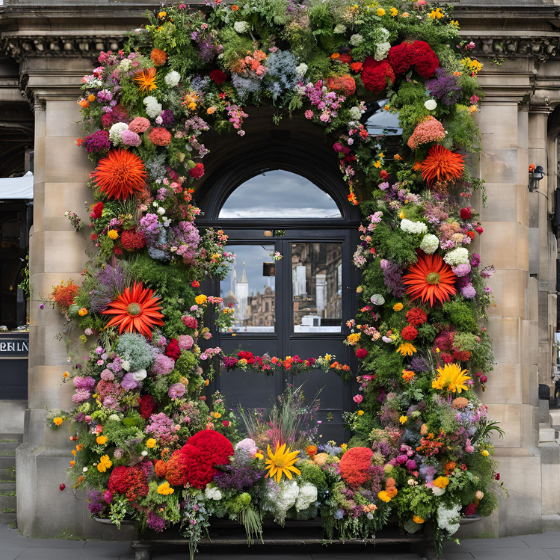
Edinburgh’s International Festival is renowned for its arts and culture, and floral displays play a significant role in this celebration. During the festival, gardens and public spaces are transformed into beautiful floral landscapes, often with themes that reflect the cultural diversity and historical richness of the city.
18. The Sydney Royal Easter Show (Sydney, Australia)
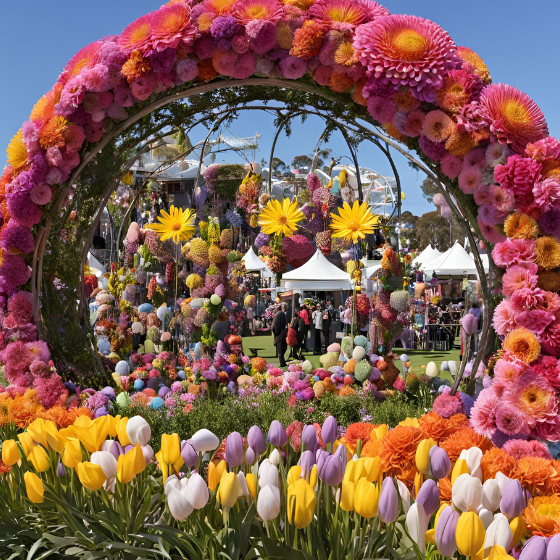
Every year, Sydney’s Royal Easter Show features a vibrant display of flowers and horticultural art. The event includes competitive floral arrangements and large-scale installations showcasing Australian flora, celebrating the country’s native flowers and plants. This event is a reflection of Sydney’s outdoor lifestyle and its commitment to showcasing local culture and creativity.
19. The Buenos Aires Rose Garden (Buenos Aires, Argentina)
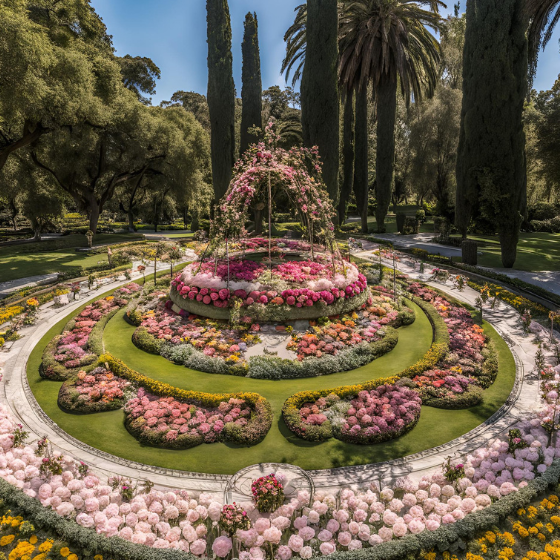
The Rose Garden in Buenos Aires is one of the city’s most beloved green spaces. With over 18,000 rose bushes, the garden’s carefully curated floral displays are a testament to Argentina’s European influence and cultural reverence for nature. It serves as both a peaceful retreat and a symbol of the city’s artistic sensibilities.
20. The Florence Flower Festival (Florence, Italy)

Florence, the birthplace of the Renaissance, celebrates its historical relationship with flowers through the Florence Flower Festival. The city’s gardens and squares are transformed into beautiful floral installations, often inspired by the rich artistic and botanical traditions of the region.
21. The Tokyo International Flower Festival (Tokyo, Japan)

Held in the heart of Tokyo, the Tokyo International Flower Festival is a major event that attracts floral designers from around the world. The festival features elaborate floral arrangements, art installations, and workshops, celebrating both Japan’s tradition of flower arranging and the global influence of contemporary floral art.
Conclusion
Floral designs are a powerful tool for cities to express their identity, celebrate their cultural heritage, and engage both residents and visitors. These elaborate displays offer not just a feast for the eyes but a deeper connection to the city’s spirit and its relationship with nature. From Tokyo’s blend of tradition and modernity to the vibrant flower parades of Medellín, these floral masterpieces capture the essence of each city — highlighting their beauty, creativity, and resilience.
Next time you visit a city, take a moment to look for its floral designs. Whether they’re part of a temporary festival or an enduring public garden, these flowers are more than just decoration — they are part of the city’s living history, offering insight into its heart and soul.

